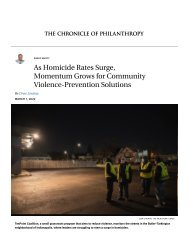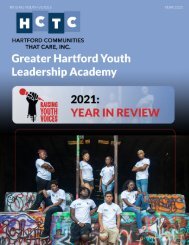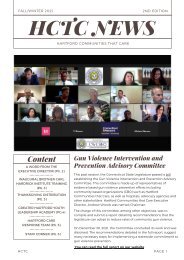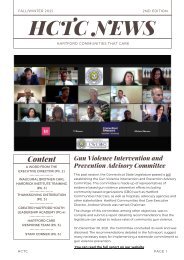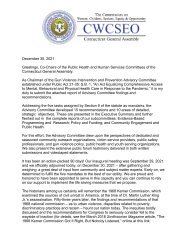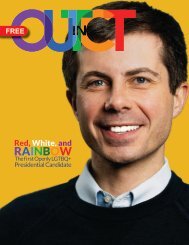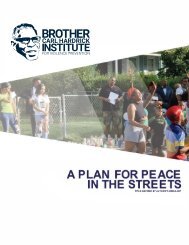HCTC 2021 Report
Create successful ePaper yourself
Turn your PDF publications into a flip-book with our unique Google optimized e-Paper software.
SAVING LIVES
The High Stakes of Violence Prevention
2020 Annual Report | Hartford Communities That Care
1
Letter from the Executive Director
Applying the Lessons of 2020 to Public Health Crises
Not since the Spanish Flu of 1918 has a pandemic harmed and
robbed so many lives as has COVID-19 over the past year. As its
outbreaks kindle and re-kindle through this day, trauma-informed
workers out of our North End oasis at Hartford Communities
That Care (HCTC) continue to counter this latest insult to injury,
a crisis being absorbed disproportionately by those already most
vulnerable to the public health crisis of community violence in our
neighborhoods.
At first, we were back on our heels in this new normal of threats to
residents’ jobs, schooling, health, and lives. But we quickly teamed
up with our seasoned and newest partners to make adjustments
in real time, delivering personal
protective equipment and face
masks and communicating reliable
information about COVID-19.
We used a combination of oldfashioned
sweat equity and modern
virtual technologies to continue to
serve our primary clients: the victims of gun violence and their
families and loved ones at the center of our mission for more than
two decades. We learned anew what crisis response entails.
Especially given the unpredictability of a national response more
attuned to confusing PR than infection control, with business
and school operations frequently changing, 2020 presented
an extreme test of our personal and professional capabilities
as frontline intervenors. We knew going in that our clients’
confidence in government had long since been overdrawn,
yet found that our round-the-clock resolve over the years had
built considerable public trust in preventive work. Indeed, our
Our reputation for service turned out to be
a crucial lifeline in 2020 for the unserved
and underserved families on whom the
pandemic piled unforeseen layers of risk.
reputation for service turned out to be a crucial lifeline in 2020 for
the unserved and underserved families on whom the pandemic
piled unforeseen layers of risk.
As this report details, HCTC combines uniquely local civic
engagement with expert medical, state, and national advocacy
to continuously improve our crisis response, clinical care, and
youth leadership development programs. Notably, our Hartford
Care Response Team’s crisis response partnership since 2004
with Trinity-Saint Francis Hospital was the first in the state to
join the national network of hospital-based violence intervention
programs (HVIPs) of the Health Alliance for Violence Intervention
(the HAVI) network. Augmenting
this network, the new CT HVIP
Collaborative we initiated with medical
and frontline intervenor partners
— and supportive legislators — is
working to expand and sustain HVIP
services statewide, linking prevention
to federal Victims of Crime Act and Medicaid resources.
In a real sense, the pandemic, economic, and racial justice
crises that blew up in 2020 have reinforced our motivation —
and inspiration — to fine tune our capabilities and achieve even
greater positive results in 2021 and beyond.
Andrew Woods, MSW, VPP
HCTC Executive Director
2
Overview
Hartford Communities that Care (HCTC) has been focused on
violence prevention and developing community relationships
since 1998. In this year of extremes, HCTC was able to draw upon
deep community connections to pursue not only its primary
mission, but also to address the dueling crisis of an overdue
national reckoning with the many inequitable systems of deepseated
racial injustice.
The HCTC umbrella covers four programs, each designed and
staffed as fully as possible to implement best practices with
measurable outcomes: The Hartford Care Response Team; the
CT HVIP Collaborative; the Greater Hartford Youth Leadership
Academy; and the Community Health Worker Program.
This report spotlights how each program
has adapted to address the festering public
health crisis of urban gun violence, even as
those painful conditions worsened with the
unfolding crises of COVID-19 and its economic
fallout.
In each program, HCTC in 2020 relied upon civic engagement and
advocacy, in partnership with government, private, and nonprofit
agencies here, statewide — and across the nation — to expand
services and broaden the scope of interventions on behalf of
unserved and underserved families, primarily young men of color.
Building coalitions has been a core HCTC strategy since its
founding. This year, pursuing our mission of preventing and
reducing community violence, we added Bridgeport StreetSafe
as a partner in our CT Hospital Violence Intervention Program (CT
HVIP) collaborative. Partnerships with our frontline counterparts
in New Haven deepened with several capacity building sessions.
At the same time, we continued to develop relationships within
Hartford and with key legislators, including Senator Douglas
McCrory, Speaker of the House of Representatives Matt Ritter
and Representative Jillian Gilchrest. On the federal level, we
enhanced our longtime collaborations with Rep. John Larson
and Senator Chris Murphy, whose support of our March For Our
Lives youth chapter has been ongoing — and whose book The
Violence Inside Us illuminates our work. In 2020, the North End
neighborhood served by HCTC experienced unprecedented food
insecurity and a striking rise in violence right along with the high
infection rates of the novel coronavirus disease of COVID-19.
Responding at the neighborhood level with longtime Community
Safety Coalition partners (see the listing at the close of this
report) and Harriott Home Health Services, among many other
advocates, timely delivery of food, face masks, and infectioncontrol
information touched more than 300 families. Walk-up
and drive-in testing events at conveniently located mobile sites
served more than 1,100 residents. Our new Community Health
Worker Program to enhance neighborhood outreach makes
further advances in outreach every week.
Throughout these difficult months, the Greater Hartford Youth
Leadership Academy (GHYLA) continued to thrive under Director
Eddie Brown. During this year in particular, culturally competent
youth leadership development required significant growth in data
interpretation and problem-solving skills.
Our youth responded by dovetailing research with deeper
knowledge of their community, and by sharpening their skills in
communications and dialogue to become stronger advocates,
both individually and as a cohort. Understanding the high stakes
of violence prevention, we are professionalizing this work.
3
The Mission of
Hartford Communities That Care
As a leader and advocate for victims of violence and trauma in
underserved communities, Hartford Communities That Care
(HCTC) has earned neighborhood trust over more than 20 years,
focused on our mission:
HCTC shall create a non-violent and drug-free environment
through the coordination of vital services, promotion of
education and healthy lifestyles and practices, and by the
formation of collaborative partnerships with key members
of the community.
With our partners in crisis response, clinical care, and youth
leadership development, we have focused on preventing and
reducing gun violence and improving health outcomes for more
than two decades.
4
Contents
Four Core Programs
I. The Hartford Care Response Team
II. The CT HVIP Collaborative
III. The Greater Hartford Youth Leadership Academy
IV. The Community Health Worker Program
Emphasis on Professional Development
Partners
5
6
Four Core Programs with
Measurable Outcomes
I. The Hartford Care
Response Team
In 2004, HCTC partnered with Saint Francis Hospital to form what is now
the Hartford Care Response Team (HCRT), a hospital-based violence
intervention program (HVIP). It has since intervened and provided care
to more than 1,200 victims of violence and their families and loved ones.
With research showing victims affected by violence are at higher risk to
re-experience violence or be re-injured, the HCRT engages with victims
as soon as allowed — often at bedside right
after injury, when trauma informed support can
be a powerful force in creating positive future
outcomes. From this critical “golden moment”
on, the response team builds a relationship
with the victim and family, following best
practices. Under a 2019 Victims of Crime Act
(VOCA) grant, the HCRT has been able to
further expand offerings, connecting families
to the physical health, mental health, and wraparound social services
that help prevent and reduce crime in our community.
Provided care to more than
1,200
victims of violence and their
families.
7
In 2020, Program Director Larry Johnson and Lead Case Manager
Shenell Benjamin led the HCRT through a tumultuous year of
shootings, providing care and support to well over 200 individuals
and families impacted by violence. Increased gunshot injuries as
well as the rates of COVID-19 infections have required the HCRT
to expand its services in concert with local and statewide HVIP
partners and seasonal workers. During this time, team members
participated in a number of professional development trainings and
networking opportunities geared to sharpen their skills and forge
meaningful relationships that help buffer the traumatic stressors
associated with the demands of this work. These activities included:
• The Health Alliance for Violence Prevention
(the HAVI) Brave Space Networking
• The HAVI’s Violence Prevention Professional
Certification Training (VPP)
• The Johns Hopkins University COVID-19 Contact
Tracer Certification Course
Additionally, Mr. Johnson capped off the year by accepting a special
invitation to apply to participate in the HAVI’s new working group,
Empowering the Front Line. It will convene a small team of front
line workers to lead professional development reform by analyzing
remuneration and creating a national pay-matrix for front line work;
developing and maintaining a resource binder for front line workers;
and planning and facilitating a quarterly “Brave Space” to assist
colleagues in building camaraderie and comparing notes on case
management. The first monthly meeting will be in January 2021.
In 2020, the HCRT has been able to continue its mission of coordinating
critical services and implementing evidence-backed interventions.
This proved especially vital in the months since COVID-19 hit and staff,
volunteers and community partners were forced to pivot and expand
existing services to meet new, urgent needs.
Case Management
HCRT outreach goes beyond the traumatic incident, as case
managers continue follow up with victims for six months to a year
after incidents. Frequently, many of the victims and families who
did not immediately accept services will re-engage with HCRT
months later. To reduce the probability of re-victimization, HCRT
provides wide-ranging wraparound assistance, as its assigned
case managers assist with housing and food support. These case
managers also facilitate accessing funds from VOCA to support
funeral expenses and other costs of living.
Promoting Physical and
Mental Healing
An existing partnership with the professional nurses of Harriott
Home Health Services connects victims of crime with at-home
wound and physical health care. In addition, healing is supported
through a partnership with the Family Medical Center at Asylum
Hill. Resident physicians from the Family Medical Center (a
UCONN Health and Trinity Health New England partner) make
themselves available as needed on one day per week for home
visits to victims, reducing the burden on caregivers to find
transportation. For many victims, these services also provide
a more convenient — and less costly — alternative to their
having to return to the emergency room for procedures such
as removal of stitches. In addition to saving the families money,
at-home care saves taxpayer dollars (as they often foot the bill
for uninsured or underinsured victims). Clients’ mental health
also is supported by referrals to community partner agencies
specializing in trauma-informed, culturally responsive therapies.
8
Families Served by HCRT in 2020
Hartford Police CompStat data from January 1 through
December 26, 2020 show 222 shooting victims citywide, which
was a 56 percent increase over 2019. In cases that do not exactly
overlap (as the HCRT serves not only shooting victims, but
victims of stabbings
and violent assaults),
the HCRT specialists
connected with 195
victims of violence
region-wide in 2020,
with services also
extending to another 52 individuals — the family members and
loved ones of those victims.
Hiring Seasonal Workers
The combined impacts of COVID-19 and the rise in incidences of
violence in Hartford this year created a need for more intervention
specialists at HCTC. As the agency began to prepare for year two
of its VOCA grant funding, it was determined necessary to secure
funding for seasonal staff to do everything possible to support an
already underserved population. In all, seven temporary workers
were hired. These included additional interventionists as well as
an administrative coordinator. These hires proved to be perfectly
timed, as the community has endured a major uptick in violence
since the start of the year — and the addition of seasonal staff
members allowed HCRT to engage on some level with 97 percent
of victims. Looking ahead to 2021, the HCRT plans to retain several
of these temporary workers to continue to meet the needs of those
affected by violence.
Hearing Victims’ Voices
(2018 Photo)
Exemplifying courageous community engagement,
the late Ms. Hattie Harris served as HCTC Board
Member from 2004-2020 (pictured above with HCTC
Executive Director Andrew Woods and current Board
Chair Howard K. Hill). Her legacy of listening to victims’
voices continues today, thanks to the advocacy of State
Senator Douglas McCrory and Chief Justice Richard
Robinson, as Mr. Woods was appointed to serve on
the State Office for Victim Services Advisory Council.
It is crucial to have a Hartford community voice in this
public forum, to report challenges, patterns of need, and
trends tracked by HCTC in its direct service to nearly
1,200 victims of violence. This perspective is crucial to
lawmakers, as they align their decisions and priorities
with their urban constituents.
9
Rapid Coronavirus Response
Spring of 2020
Beginning in April of 2020, COVID-19 hit the North End Hartford
community hard. Rates of infection were high, but in addition,
the ripple effects of the pandemic had a major impact. Many
residents were receiving conflicting information about testing,
quarantining, and other virus protocols. Recognizing that many
early testing sites were drive-up only, limiting access, HCTC
with its partners Harriott Home Health Services and Hartford
HealthCare supported five walk-up mobile sites for COVID-19
testing during April, May and June. These testing events were free
and open to the community, allowing participants to safely and
quickly be tested.
HCTC knows the value of meeting the
community in a comfortable and familiar
space — as well as the importance of having
trusted community representatives at these
events.
With guidance from the Connecticut Department of Public
Health, Public Safety officers from Hartford HealthCare, and
supervision from HCTC staff, service was provided to more than
1,000 residents.
Our community partner, Harriott Home Health Services, was
instrumental to the success of the testing events, providing
technical assistance, training and leadership in the development
of safety protocols for staff and volunteers directly involved. In
addition to safely providing these protocols for the community,
HCTC provided safety equipment to its staff (including face
shields, N95 masks, gowns and gloves). Staff also were invited to
get tested at these events to make sure they were staying healthy
during their community outreach work. Longtime community
partner Fairview Capital supported this effort by providing 1,250
N-95 masks for those directly involved in the COVID-19 response
effort, which went beyond testing to include the Community
Safety Coalition’s food distribution efforts.
As the outreach became more efficient, HCRT received positive
feedback from a range of stakeholders, including clients, clergy,
and medical team members. One, Director of Medical Education
Dr. Thomas Nowicki of Hartford HealthCare, told us that “The
partnership with Hartford Communities that Care and Harriott
Home Health was instrumental in establishing a connection to
the community,” so much so that only a fraction of those tested
would have been reached without the trust HCRT has in this highneed
area. The team at HCTC managed the flow of information
efficiently and provided a familiar and comforting face while doing
so, Dr. Nowicki pointed out.
A Proactive Response
Alert to the importance of staying safe and healthy in the coming
months, HCTC has taken a proactive approach to preparation.
Identified by the Centers for Disease Control (CDC) as well as
State and regional health officials, contact tracing is an important
tool in preventing the next outbreak and to that end, HCTC has
provided access to training for all of its volunteers and staff.
This comprehensive training course, given remotely by the
Johns Hopkins School of Public Health, provides wide-ranging
knowledge of the evolution of COVID-19 and the importance of
contact tracing to controlling spread — as well as guidance as to
its practical application. Each of the 15 HCTC staff and volunteers
completed this training by May 31, 2020, in preparation for the
frontline support efforts moving forward.
10
Meeting the Urgent Need for Food
The COVID-19 pandemic did not create systemic issues of
food insecurity, but it exacerbated the shortages families
previously faced. In its role as a member of the Community
Safety Coalition (CSC), HCTC took the lead in obtaining fresh
food, nonperishables and hygiene products to provide to the
most vulnerable. These activities involved the entire CSC team,
which includes; the Blue Hills Civic Association, COMPASS Youth
Collaborative, Mothers United Against Violence, and the YMCA of
Greater Hartford-Wilson Gray YMCA.
During the spring, the CSC’s biweekly food distribution effort
tapped numerous community agencies to identify families in
need.
Altogether, 200 families and 85 seniors
received fresh fruit and vegetables, nonperishable
food items, toilet paper and other
cleaning and personal sanitary products, as
well as individual masks and information on
COVID-19 testing and available resources.
Over the five distributions led by HCTC, 11,720
pounds of fresh produce were distributed.
the pandemic, including safety protocols and resources for
testing and care.
Speaking for many during the spring 2020 pandemic
outbreak, a food recipient named Debra took time to
communicate her thanks, revealing that the family members
on whom she usually could depend simply did not have food
to share. Hence, the “nice and fresh, not old” vegetables
supplied by the HCRT were right on time, she told us.
In planning the logistics for these deliveries, the Community
Safety Coalition, with HCTC leading the effort, followed
CDC guidelines to ensure that staff, volunteers, agency
professionals and clients could efficiently and safely pack,
sort, and receive all items. Safety and maintaining the CDC
guidelines were the dominant factors guiding this process, as the
numbers of volunteers were kept to a minimum and assignments
staggered. Each volunteer received personal protective
equipment (PPE) in the form of a gown, gloves, an N95 mask and
an optional face shield. The N-95 masks provided by Fairview
Capital were disseminated as part of this effort.
HCRT Program Director Larry Johnson noted that the delivery
of food during the height of the first wave of the pandemic,
from March to June 2020, also helped make meaningful contact
possible with clients who had become isolated. Food distribution
became a way for the Community Safety Coalition to not only
make sure the basic needs of its constituents were being met —
but also provided a means to distribute information specific to
Hartford Community Safety Coalition Partners Mother’s United Against Violence and
COMPASS Peacebuilders prepare deliveries
11
II. The CT HVIP
Collaborative
Across the nation and internationally, a leading-edge best practice
for preventing and reducing community violence is the hospitalbased
violence intervention program (HVIP) model. In Hartford
and statewide, interest in the multidisciplinary teamwork of HVIPs
has grown among medical institutions and community agencies
alike — and led to HCTC’s formation in January 2020 of the CT HVIP
Collaborative (CT HVIP).
12
In its inaugural year, the CT HVIP built upon and expanded the
14-year partnership between HCTC and Saint Francis Hospital —
the Hartford Care Response Team founders — and extended the
HVIP hospital/community agency safety net across Connecticut.
New hospital and community partners include Yale-New Haven
Hospital and its frontline agency, the CT Violence Intervention
Program, as well as the emerging HVIPs of Hartford Hospital and
Connecticut Children’s Medical Center and emerging community
partner, Bridgeport StreetSafe.
Our national partner, the Health Alliance
for Violence Intervention (the HAVI),
has provided policy guidance, training
and technical assistance along the way,
including, in December of 2020, an
intensive, six-day Violence Prevention
Professional (VPP) certification session
providing frontline workers with details
on the continuity of best practices.
The CT HVIP will continue to move forward in 2021 with a focus
on building out our three work groups (Policy, Research &
Evaluation, and Training & Technical Assistance) and will continue
to steward relationships with vital partners that include the
Connecticut Hospital Association, the Hartford Foundation for
Public Giving and leaders in the Connecticut General Assembly.
several committees at the General Assembly. During the 2020
Legislative Session, Executive Director Woods was asked to
present before the Legislature’s Medical Assistance Program
Oversight Council (MAPOC) Women and Children’s Health
Subcommittee. Co-chaired by Rep. Jillian Gilchrest and Amy
Gagliardi, this subcommittee sought and received presentations
on the new CT HVIP collaborative, as well as the cost savings
in Medicaid and other taxpayer benefits demonstrated through
HCTC interventions.
Key Legislative Relationships
Amidst COVID-19 outbreaks, our CT HVIP hospital and frontline
partners have continued to brief legislative partners,
including Congressman John Larson, State Sen. Douglas
McCrory, and State Reps. Matt Ritter and Jillian Gilchrest (among
others), on HVIP capacity building. By monitoring other states’
legislative and administrative techniques to fund prevention
work under the federal Victims of Crime Act (VOCA) and via
Medicaid reimbursement, we also are exploring options for how
Connecticut can support best prevention practices through a
legislative allocation.
CT HVIP at the Capitol
Hartford Communities that Care Executive Director Andrew
Woods, along with program partners across the agency and
its CT Hospital Violence Intervention Program collaborative
(CT HVIP), have had the opportunity to make presentations to
Youth Leader Joshua Fee interviews CT House Speaker Matt Ritter
13
III. The Greater Hartford
Youth Leadership
Academy
With its focus on culturally-conscious youth
leadership development ever since the founding
of HCTC in 1998, the Greater Hartford Youth
Leadership Academy (GHYLA) is a cornerstone
of this agency. Following the tragic surge of gun
violence in the city in the early 2000s, HCTC was
forced to expand its reach and create a crisis
response team that gradually added clinical care
and wraparound recovery services to prevent
and reduce gun violence.
14
HCTC’s original commitment remains: to engage young people
of color in the prevention and reduction of community violence,
encouraging their growth as advocates. This we accomplish
through leadership development activities through which
young people identify problems, research root causes and local
conditions, and develop data-driven recommendations that
elevate issues of concern to them, their families and their peers.
In 2020, the adaptation of the GHYLA to adjust to the pandemic
was far and away one of the bright spots of our organization, as
these highlights demonstrate:
1. Guided by Program Director Eddie Brown, the youth leaders
refined their existing “Raising Youth Voices” podcast series to
further the cause of uncovering and addressing root causes
of urban gun violence. Whereas the youth in recent years had
been practicing the process of researching issues, preparing
questions based on data, and engaging community, statewide
and professional leaders in dialogue, the COVID-19 outbreak
challenged them to delve into new issues — and acquire new
skills.
2. In addition to creating and executing its podcasts, the GHYLA
researched numerous topical issues by participating in
online Zoom and WebEx forums, including a probe of police
accountability measures as passed by the U.S. House of
Representatives in its George Floyd Justice in Policing Act
(with Congressman John Larson).
3. In January of 2020, the youth attended the 18th annual
college recruitment fair of the Historically Black Colleges
and Universities (HBCUs) in suburban Washington, D.C.
— the largest annual such festival in the nation. Offerings
included on-site admissions interviews, music auditions, and
information about application fee waivers and scholarships, as
well as seminars on successful transition to college.
Civic Engagement for Youth
Engagement of youth in the civic landscape is
one of the greatest drivers of their active roles
in shaping future policy. The Greater Hartford
Youth Leadership Academy (GHYLA) has
continued to build and maintain relationships
with elected leaders and their staff members,
including Congressman John Larson’s office. The
GHYLA’s ongoing “Raising Youth Voices” podcast
series is an increasingly vibrant platform for this
engagement. In fact, throughout 2020, the youth
conducted interviews with key state and national
policy makers as well as violence prevention
specialists — and their podcasts served as a forum
for the youth to engage each other and many
diverse professionals in guided conversations
illuminating urgent issues and historic inequities.
Understanding the landscape and the context
of specific policies to alleviate poverty, equalize
education, and prevent violence and trauma, as
related to preventing urban gun violence, has been
a priority for the GHYLA since 2017.
15
4. The GHYLA leaders studied critically important issues related
to Community-Based Violence Intervention and Prevention;
Education During the New Normal of COVID-19; and Child
Injury and Fatality Prevention services. These issues provided
the framework for conversations during the year with peers,
community leaders and health policy leaders, leading to
the presentation of youth perspectives in the continuously
expanding virtual podcast series [available on YouTube, by
searching “Raising Youth Voices”].
5. The youth participated in a national stakeholder meeting
with Trinity Health of New England/St. Francis Hospital,
the national, Child Safety Forward Initiative to Reduce
Child Abuse and Neglect Fatalities and Injuries through a
Collaborative, Community-Based Approach. This featured
weeks of youth preparation and ongoing research into Child
Injury and Fatality Prevention services, which led the youth
to develop and present final recommendations at a national
online workshop.
6. In the fall, the youth participated in the “Excelerator: A
Community in Action Initiative of the Alliance for Strong
Families and Communities,” a four-session series focusing
on Using Lessons Learned from Natural Disasters and
Tragedies to Inform COVID-19 Response and Recovery
Activities; Building Justice and Equity in Child Welfare
Agencies; Resilience and Learnings from Brain Science; and
21st century Child and Family Well-being Systems and a Pivot
toward Prevention. For each of these 90-minute sessions,
the youth participated as commentators, synthesizing
their perspectives after hearing from social workers,
neuroscientists, agency CEOs, and both providers and
recipients of child welfare services. In addition to sharing their
reactions and understanding of the content and previewing
forthcoming topics, the youth experienced high-level analyses
of the data and issues regarding family separation.
7. The interchanges spanned the youth participants’ own
firsthand experiences with foster care as well as their
conceptualization of potential improvements to reduce the
system’s negative impacts of stress and trauma on physical
health [these conversations also can be found on the GHYLA’s
“Raising Youth Voices” YouTube Channel].
The GHYLA youth leaders also continued to form partnerships
and expand their engagement in community, as, for example, by:
• Providing access to weekly sessions both in person and
online to make sure every participant could attend in a
way that was comfortable to them and their families.
• Assisting with the packing and distributing of fresh food
and sanitary supplies for 300 families over five events at
the height of the pandemic.
• Establishing partnerships with Trinity Health of New
England (the St. Francis Hospital Hartford Team) for
the Child Safety Forward Initiative and The Alliance for
Strong Families and Communities, including formation
of a Child Injury and Fatality Prevention work group
and presentation of recommendations to various
stakeholders for multiple discussions.
• Connecting three youth to become Youth Planning
Council members for an upcoming State of Health Equity
Among Boys and Men of Color Summit, scheduled for
June of 2021 (to be hosted by UConn’s Health Disparities
Institute).
16
• Leading a conversation across racial and socioeconomic
divides, in partnership with the Jewish Teen Learning
Connection of West Hartford, deepening civic
engagement.
• Attending the National Action Network’s “2020
Commitment March: Get Your Knee Off Our Necks,”
in Washington, D.C., celebrating the 57th Anniversary
commemoration of the “I Have a Dream” speech of
Dr. Martin Luther King, Jr. The 12 youth who attended
heard from civil rights leaders as well as family
members of recent victims of police violence, in an
inter-generationally-inclusive day of advocacy for
comprehensive police accountability reform; the Census;
and mobilization of voters for the November 2020
election.
• Joining Blue Hills Civic Association for a focus Group
led by Dr. Reginald Eadie, President and CEO of Trinity
Health of New England, on what the medical community
can do to earn and deserve increased trust from the black
community around public health interventions, including
the COVID-19 vaccine.
• Currently collaborating with Hartford Parent University
and the Child Safety Forward’s parent and community
engagement workgroup to host a Safe Sleep Awareness
Virtual Conference in January 2021.
National Networking
This year, HCRT Program Director Larry Johnson
joined the ranks of HCTC staffers serving on the
national workgroups of the key CT HVIP policy
partner, the Health Alliance for Violence Intervention
(the HAVI). This special working group will consist of
a small team of front line workers who will conduct
comparative analyses of how programs are paying
workers, create a national pay-matrix for front line
work, create and maintain a resource binder for front
line workers, and plan and facilitate a quarterly Brave
Space. The first meeting will be in January 2021 and
the working group will meet monthly thereafter.
Having served since 2018 on the HAVI’s Policy and
Research & Evaluation working groups, Andrew
Woods has been invited to be a member of the
HAVI’s Racial Equity Task Force, an opportunity to
work with colleagues nationwide to develop a shared
framework and understanding for promoting racial
equity — as a key component in all aspects of our
work. As a Task Force member, Mr. Woods will join
other HAVI Member Programs, Staff, and Advisory
Board Members in advancing racial equity policies
and practices within the organization. The first
meeting will be in February 2021.
17
IV. Community Health
Worker Program
In 2021, providing residents
more than
each
week to
500masks prevent the
spread of
Covid-19.
Darlene Childs was welcomed in the fall to lead
HCTC’s newly established Community Health
Worker Program, funded by the Connecticut Health
Foundation and the City of Hartford, with partners the
Hispanic Health Council and Family Life Education.
A regional initiative to continue the public health
response to the pandemic, the program in its first
months hired Community Health Workers (CHWs)
to provide outreach, education, and distribution of
COVID-19 information to more than 3,000 Greater
Hartford residents and merchants.
18
In addition, staff from the Community Health Worker Program
have — or are working towards — degrees in these areas
of focus: Human Services, Criminal Justice, Business and
Accounting.
The activities of the CHWs included:
• Distribution of face masks, hand sanitizers and tips to
prevent COVID-19 infection, where to get tested and available
resources and support for those affected by the virus;
• Collaboration with Howard K. Hill Funeral Services to
distribute more than 10,000 boxes of food to residents across
Greater Hartford, including public health (COVID-19) and
public safety (victims of violent crime) information.
• Participation in a number of professional development
trainings, including:
• The Johns Hopkins University COVID-19 Contact
Tracer Certification Course
• The HAVI’s Violence Prevention Professional
Certification Training (VPP)
• Privacy considerations under the Health Insurance
Portability and Accountability Act (HIPAA)
• Crisis Prevention and Intervention (CPI)
• The American Red Cross First Aid and CPR
Training
In 2021, the Community Health Workers are continuing frontline
outreach to the Greater Hartford community, providing residents
and merchants more than 500 masks each week to help prevent
the spread of Covid-19. Plans also call for the new Community
Health Workers to track trends in virus surge; distribute
masks and information on testing sites; and provide resources
concerning basic needs such as food and housing.
Bringing Federal Support Home
According to data from the Census Bureau, the City
of Hartford had one of the lowest rates of returning
census forms in Connecticut. In an effort to raise
the number of surveys returned and increase the
level of representation from Hartford, HCTC was
honored in August of 2020 to partner with Blue
Hills Neighborhood Block Watch Leader Rhonda
Leonard, who hosted Senator Chris Murphy’s efforts
to raise awareness on the importance of completing
the decennial U.S. Census. During this outreach,
Senator Murphy engaged dozens of residents in
the Blue Hills neighborhood, gaining insight on
the challenges faced by residents and sharing why
it’s important to complete the Census, both from
the standpoint of the community’s demographic
characteristics related to wealth inequality and its
eligibility for future programmatic resources.
On another front, Congressman John Larson
partnered with HCTC to host a Small Business
Administration (SBA) Forum, at which small minority
businesses met with the SBA, bankers and credit
union lenders concerning supports for enterprises
impacted by COVID’s drag on profits.
19
Emphasis on Professional
Development
Despite the pandemic — and in response to it — HCTC leadership
maintained its focus on providing professional development and
training to staff and volunteers. These sessions ensure increased
knowledge of best practices and effective continuity of services.
Below is a sampling of staff and volunteer trainings completed
and workshops that staff and volunteers attended during 2020 to
continue enhancing their working knowledge.
Frontline Workers Capacity Building Session,
Health Alliance for Violence Intervention (the HAVI)
Brave Space, the HAVI
FRONTLINE VIOLENCE & Organizational Practice, the HAVI
The HAVI Violence Prevention Professional (VPP)
Certification Training
Engagement with Families Affected by Violent Crime,
HCRT - Crisis Intervention Training
COVID-19 Contact Tracing, Johns Hopkins University
LIMITED ENGLISH PROFICIENCY (LEP),
Connecticut Judicial Branch
INTIMATE PARTNER VIOLENCE, Network of Care
FOOD INSECURITY, Network of Care
MENTAL HEALTH WELLNESS & RES0URCES,
Network of Care
STOP THE BLEED, Saint Francis Hospital
DCF Mandatory Reporter Training, Saint Francis Hospital
History of Hartford Violence, Training Consultant,
Carl Hardrick
IMMIGRATION & LEGAL MATTERS, West Indian Foundation
Hospital Violence Intervention Program,
HVIP Onboarding Training
The Health Insurance Portability and Accountability Act (HIPAA)
Preventing Gun Violence in The Big 3, HVIP Collaborative
20
Staff List
Andrew Woods, MSW, VPP
HCTC, Executive Director
Director, CT Hospital Violence Intervention Program Collaborative
Joseph Wilkerson, MBA
Deputy Director/ HR
Edward Brown, BS, Director
Greater Hartford Youth Leadership Academy
Shenell Benjamin, AS, VPP, Director of Case Managers
Hartford Care Response Team
Larry Johnson, VPP, Director
Hartford Care Response Team
Darlene Childs, MS, VPP, Coordinator
Community Health Worker Program
Areader (Ari) Cruz, MSW, VPP
Case Manager
Daniel Palmer, BS, VPP
Intervention Specialist/ Community Health Worker
Winston Kennedy, VPP
Intervention Specialist/ Community Health Worker
Samariya Smith, MSW, VPP
Intervention Specialist
Kelvin Lovejoy, AS, VPP
Intervention Specialist
Clifton Drayton, BS
Community Health Worker
Sherelle Reid, AS
Community Health Worker
Jennika Lebron, BS
Community Health Worker
Aaron Ellis
Community Health Worker
Annual Report Contributors:
Andre Harris, Photographer
Aaron Ellis, Photographer
Johanna Schubert, Writer & Administrative Coordinator, CT HVIP
Kent Ashworth, Writer & Researcher
21
Partners
The partners of HCTC — and advocates of its work — are instrumental to all progress:
Congressman John Larson
Senator Douglas McCrory
State Representative Matt Ritter
State Representative Jillian Gilchrest
State Representative Josiah Hall
State Representative Bobby Gibson
American Eagle Financial Credit Union
Bridgeport StreetSafe
Capital Workforce Partners
CENCAP Federal Credit Union
Connecticut Against Gun Violence
Connecticut Children’s Medical Center
Connecticut Department of Emergency Services
and Public Protection
Connecticut Department of Public Health
Connecticut Health Foundation
Connecticut Hospital Association
Connecticut Violence Intervention Program
Elizabeth Schiro and Stephen Bayer
Everytown Against Gun Violence
Giffords Law Center
Harriott Home Health Services
James & JoAnn Price Community Safety Fund
Hartford Foundation for Public Giving
Hartford Hospital
Phillips Health Center
The Health Alliance for Violence Intervention (The
HAVI)
Trinity Health of New England
(Saint Francis Hospital and Medical Center)
Trinity College
UCONN Health
Yale New Haven Hospital
YWCA Hartford Region
Hartford Community Safety Coalition Partners:
Blue Hills Civic Association
COMPASS Peacebuilders
Mothers United Against Violence
YMCA of Greater Hartford (Wilson-Gray)
22
2550 Main Street, 3rd Floor
Hartford, CT 06120
Phone: 860.724.1223
Fax: 860.724.1225
www.hartfordctc.org
23
24
In this year of extremes, HCTC drew upon
deep community connections to help address
multiple public health crises: COVID-19,
its economic distress … and the overdue
national reckoning with the many inequitable
systems of deep-seated racial injustice.






